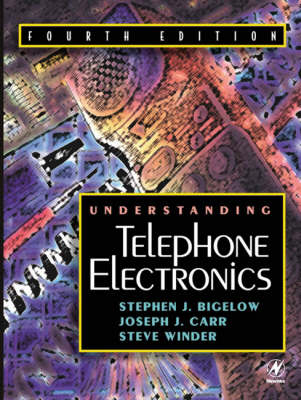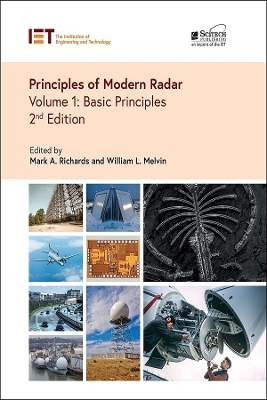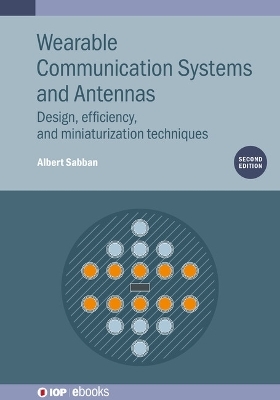
Understanding Telephone Electronics
Newnes (an imprint of Butterworth-Heinemann Ltd ) (Verlag)
978-0-7506-7175-0 (ISBN)
Throughout its history, Understanding Telephone Electronics has been, by far, one of the most popular books on telecommunication electronics in the trade, electronic distribution, and educational markets because of its very simple, direct approach to the technology. In keeping with the distinguished tradition of its predecessors, Understanding Telephone Electronics, Fourth Edition covers conventional telephone fundamentals, including both analog and modern digital communication techniques, and provides basic information on the functions of each telephone system component, how electronic circuits generate dial tones, and how the latest digital transmission techniques work.
This new edition of Stephen Bigelow's well-known, widely used text on telephone electronics offers comprehensive coverage of the latest developments in fiber optic technology, the convergence of telecommunications, cable-TV and Internet services, and CTI (computer telephony integration). The authors have made extensive revisions in these and other essential areas, such as business systems, voice mail, phone networking, enhanced services, satellite communications, wireless paging systems, digital communications, and much more to ensure that topics covered are current with the most recent advances in technology. The original Understanding Telephone Electronics has been a "gold standard" reference and training staple for years. Likewise, Understanding Telephone Electronics, Fourth Edition will serve as an essential and invaluable resource for technicians, engineers, students at major universities and corporations, and anyone with an enthusiasm for telecommunication electronics.
Joe Carr devoted his life to furthering a wider understanding of electronics and spreading his passion for radio, becoming one of the USA’s best known technical authors with over 25 books and hundreds of magazine articles to his name. Newnes is proud to have published a number of his recent titles, including his last book, RF Components and Circuits. Steve Winder is now a European Field Applications Engineer for Intersil Inc. Steve works alongside design engineers throughout Europe to design circuits using components made by Intersil Inc, a US based manufacturer of CMOS ICs used for power supply controllers and for analogue signal processing.Prior to joining Intersil Inc., Steve worked for US based Supertex Inc. in 2002, where he was instrumental in encouraging Supertex’s management to start developing LED drivers. One of Steve’s German customers had started using a relay driver for LEDs and once Steve had explained the technical detail of this application to Supertex’s management, they decided to start an applications team to develop LED specific products. Supertex then invested heavily to became a leader in this field. Microchip acquired Supertex in 2014.Until 2002, Steve was for many years a team leader at British Telecom Research Laboratories, based at Martlesham Heath, Ipswich in the UK. Here he designed analog circuits for wideband transmission systems, mostly high frequency, and designed many active and passive filters.Steve has studied electronics and related topics since 1973, receiving an Ordinary National Certificate (ONC) in 1975 and Higher National Certificate (HNC) in 1977 with Endorsements in 1978. He studied Mathematics and Physics part time with the Open University for 10 years, receiving a Bachelor of Arts Degree with 1st Class Honours in 1989. He received a Master’s Degree in 1991, in Telecommunications and Information Systems after studying at Essex University. Since 1991, he has continued with self-study of electronics, to keep up-to-date with new innovations and developments.
Ch. 1 The Telephone System--About This Chapter, The Telephone Set, The Local Loop, The Public Switched Telephone Network, Types of Transmissions, Switching Systems, Transmission System Facilities, System Operating Conditions, Telephone Equipment Registration, Ch. 2 The Conventional Telephone Set—About This Chapter, Switchhook, Pulse Dialing, Anti-Tinkle and Speech Muting, Tone Dialing, Transmitter, Receiver, Electromechanical Ringer, The Hybrid Function, The Electronic Telephone, What Have We Learned?, Quiz; Ch. 3 Electronic Speech Circuits—About This Chapter, DC Requirements for the Local Loop, Two-Way Speech Block Diagram, Protection Circuits, Speech Circuit, DC Line Interface, Transmitter Section, Receiver Section, Line Balancing, Telephone Set Volume Compensation, Availability and Characteristics of Integrated Circuit Speech Networks, What Have We Learned?, Quiz; Ch. 4 Electronic Dialing and Ringing Circuits-- About This Chapter, Dial Pulse Generation Using Integrated Circuits, Circuit Power and Voltage Transients, Pulse Dialer, DTMF Dialing Using Integrated Circuits, Combined Dialers, Electronic Ringer, Electronic Ringer Implementation Example, Complete Integrated Telephone, What Have We Learned? Quiz; Ch.5 Integrated Telephone Circuits-- About This Chapter, The MC34010 Single-Chip Telephone, Using A Microprocessor, Applying the Telephone Circuit, Speakerphones, Integrated Speakerphone Circuits, What Have We Learned?, Quiz; Ch.6 Digital Transmission Techniques-- About This Chapter, Digital Signals, Signal Conversions, Advantages and Disadvantages of Using Digital Signals, Waveform Coders, Time Division Multiplexing, What Have We Learned?, Quiz; Ch.7 Electronics in the Central Office--About This Chapter, The Local Loop, Conventional Central Office Interfaces, Lineside Interface, Trunkside Interface, Electronics in Central Office Interfaces, Combined Codec and Filter IC, Electronic Crosspoint Switching, Subscriber Loop Systems, Digital Multiplexing Equipment, What Have We Learned?, Quiz; Ch. 8 Network Transmission-- About This Chapter, Why Digital Transmission?, Line Coding, Pulse and Timing Restoration, More Line Codes, What Have We Learned?, Quiz; Ch. 9 Modems and Fax Machines—Other Telephone Services--- About This Chapter, What Is a Modem, and Why Is It Required?, Asynchronous Modem Operation, Standards for Digital Equipment Interface, Error Detection and Correction, Standards, Protocols, Facsimile, Computer Fax Devices, What Have We Learned?, Quiz; Ch.10 Fiber Optic Technology-- About This Chapter, Fiber Optic Technology, Electromagnetic Interference and System Safety, Fiber Optic Principles, Optical Characteristics of Fiber Systems, Calculating Losses in Fiber Optic Systems, Fiber Optic Communications Systems, What Have We Learned?, Quiz; Ch.11 Wireless Telephones-- About This Chapter, Cordless Telephones, Mobile Telephones, Cellular Mobile Telephone Service, Digital Communications Networks, What Have We Learned?, Quiz; Ch.12 The Convergence of Technologies-- About This Chapter, The Technology Context, Telecommunications, Cable TV, High-Definition Television, Cable Modems, Internet, The Competitive Context, The International Context, Computer Telephony Integration, What Have We Learned?, Quiz
| Erscheint lt. Verlag | 24.8.2001 |
|---|---|
| Verlagsort | Oxford |
| Sprache | englisch |
| Gewicht | 660 g |
| Themenwelt | Technik ► Nachrichtentechnik |
| ISBN-10 | 0-7506-7175-0 / 0750671750 |
| ISBN-13 | 978-0-7506-7175-0 / 9780750671750 |
| Zustand | Neuware |
| Haben Sie eine Frage zum Produkt? |
aus dem Bereich


